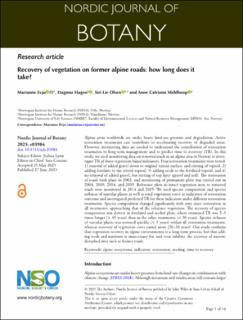| dc.contributor.author | Evju, Marianne | |
| dc.contributor.author | Hagen, Dagmar | |
| dc.contributor.author | Olsen, Siri Lie | |
| dc.contributor.author | Mehlhoop, Anne Catriona | |
| dc.coverage.spatial | Norway | en_US |
| dc.date.accessioned | 2023-07-04T12:27:22Z | |
| dc.date.available | 2023-07-04T12:27:22Z | |
| dc.date.created | 2023-06-30T10:34:02Z | |
| dc.date.issued | 2023 | |
| dc.identifier.issn | 0107-055X | |
| dc.identifier.uri | https://hdl.handle.net/11250/3075565 | |
| dc.description.abstract | Alpine areas worldwide are under heavy land-use pressure and degradation. Active restoration treatments can contribute to accelerating recovery of degraded areas. However, monitoring data are needed to understand the contribution of restoration treatments to long-term management and to predict time to recovery (TR). In this study, we used monitoring data on removed roads in an alpine area in Norway to investigate TR of three vegetation-based indicators. Four restoration treatments were tested: 1) removal of added gravel down to original terrain surface, and stirring of topsoil; 2) adding fertilizer to the stirred topsoil; 3) adding seeds to the fertilized topsoil; and 4) no removal of added gravel, but stirring of top layer (gravel and soil). The restoration of roads took place in 2002, and monitoring of permanent plots was carried out in 2004, 2009, 2014, and 2019. Reference plots in intact vegetation next to removed roads were monitored in 2014 and 2019. We used species composition and species richness of vascular plants as well as total vegetation cover as indicators of restoration outcome and investigated predicted TR for these indicators under different restoration treatments. Species composition changed significantly with time since restoration in all treatments, approaching that of the reference vegetation. The recovery of species composition was slowest in fertilized and seeded plots, where estimated TR was 2–3 times longer (> 45 years) than in the other treatments (< 20 years). Species richness of vascular plants was restored quickly (< 5 years) within all restoration treatments, whereas recovery of vegetation cover varied more (20–30 years). Our study confirms that vegetation recovery in alpine environments is a long-term process, but that adding seeds and nutrients is unnecessary for, and even inhibits, the recovery of narrow, disturbed sites such as former roads. alpine ecosystems, indicators, restoration, seeding, time to recovery | en_US |
| dc.language.iso | eng | en_US |
| dc.rights | Navngivelse 4.0 Internasjonal | * |
| dc.rights.uri | http://creativecommons.org/licenses/by/4.0/deed.no | * |
| dc.subject | alpine ecosystems | en_US |
| dc.subject | indicators | en_US |
| dc.subject | restoration | en_US |
| dc.subject | seeding | en_US |
| dc.subject | time to recovery | en_US |
| dc.title | Recovery of vegetation on former alpine roads: how long does it take? | en_US |
| dc.title.alternative | Recovery of vegetation on former alpine roads: how long does it take? | en_US |
| dc.type | Peer reviewed | en_US |
| dc.type | Journal article | en_US |
| dc.description.version | publishedVersion | en_US |
| dc.rights.holder | © 2023 The Authors | en_US |
| dc.subject.nsi | VDP::Zoologiske og botaniske fag: 480 | en_US |
| dc.subject.nsi | VDP::Zoology and botany: 480 | en_US |
| dc.source.pagenumber | 14 | en_US |
| dc.source.journal | Nordic Journal of Botany (NJB) | en_US |
| dc.identifier.doi | 10.1111/njb.03984 | |
| dc.identifier.cristin | 2159737 | |
| dc.relation.project | Norges forskningsråd: 160022 | en_US |
| dc.relation.project | Andre: Norwegian Defence Estate Agency | en_US |
| dc.source.articlenumber | e03984 | en_US |
| cristin.ispublished | true | |
| cristin.fulltext | original | |
| cristin.qualitycode | 1 | |

